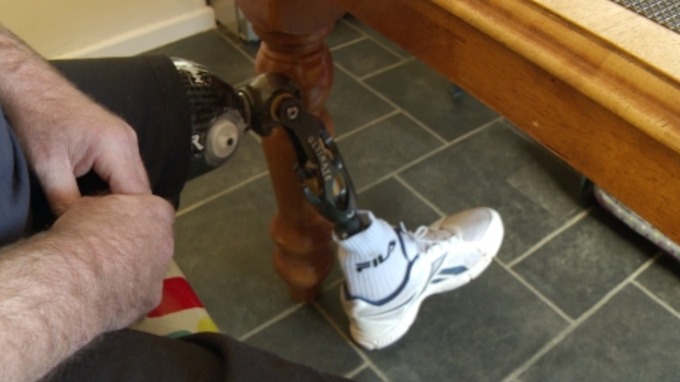An amputee with type 1 diabetes and his wife have been told that they are no longer eligible for benefits from the Personal Independence Payment (PIP). In this article we look at what this new benefit is, and who can apply for it.
Richard Hart, from Cornwall, had his left leg amputated (pictured) 15 years ago after breaking it in a fall. He is also partially sighted and awaiting surgery on an arthritic right knee.
Mr. Hart drives an automatic car as part of the Motability scheme, but only during the day because his eye problems restrict him from driving at night. However, the loss of his disability benefits means that he will no longer qualify for this car, and his wife Emma will lose her carer’s allowance.
Three years ago, Mr. Hart was granted a downstairs wet room by social services. He told ITV: “It’s made a real big difference to me. It’s hard. I couldn’t live without it now. I couldn’t, not with my leg like this, and my knee like this.”
In January, his eligibility for PIP was assessed. One week later, the Department of Work and Pensions informed Mr. Hart and his wife that he no longer qualifies for disability payments.
The DWP released the following statement:
“Decisions on eligibility for Personal Independence Payment are made after consideration of all the evidence, including an assessment and information provided by the claimant and their GP. The majority of people leaving the Motability scheme will be eligible for a one-off payment of £2,000, which will help ensure their mobility needs continue to be met.”
After Mr. Hart’s story was made public, the DWP contacted him to inform him that his case would be reassessed. A new decision is expected within two to three weeks.
It is currently unknown why Mr. Hart did not meet the PIP criteria, which replaced the Disability Living Allowance in June 2013 for UK residents aged between 16-64 years.
PIP is a benefit for people who require care for long-term illnesses which can limit their ability to live comfortably and affect mobility. It is divided into two levels: standard level and enhanced level.
Standard level is for people whose daily living and mobility is “limited”; enhanced level is for people whose mobility and daily living is “severely limited”.
Applying for PIP involves filling in a questionnaire and receiving an assessment. People with diabetes can apply in relation to a number of complications that affect their quality of living. These include neuropathy, stiff joints, frozen shoulder, visual impairments or hypo unawareness.
Based on the answers provided to each question, you will be given a score between 0-12. The maximum score on some questions can vary, but these answers will shape the decision on your application.
It may be that Mr. Hart’s daily living and mobility was not deemed as limited enough under the PIP eligibility criteria. Of course, it also could be that he did not disclose the true extent of his disability.
This is why it is important to take some time before filling out a PIP application. Note down any situations in which your life is affected by your diabetes, or another health condition, and be sure to include details such as any requirements for automatic cars, shower seats or screen readers.
If you have recently experienced any change with your disability, you need to inform the DWP of the changes, which can be contacted on 0800 9172222 or by textphone on 0800 9177777.
This article will be updated with the latest developments regarding Mr. Hart’s application.
Picture: ITV West Country




